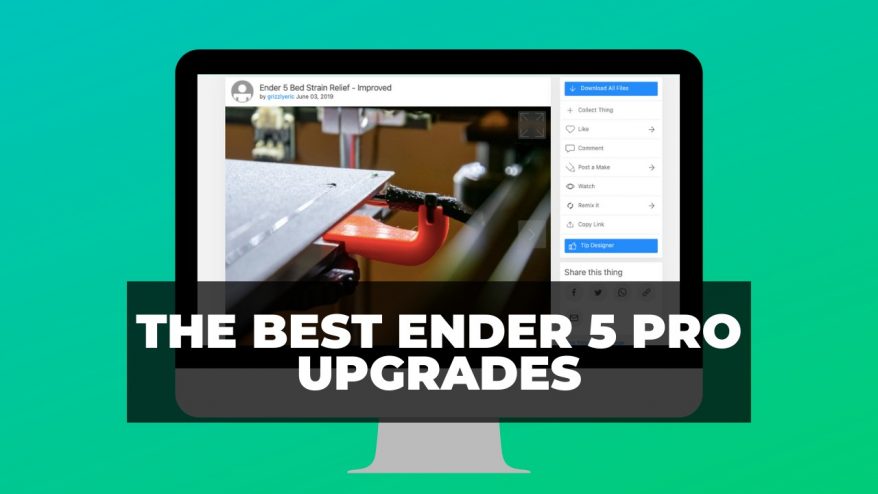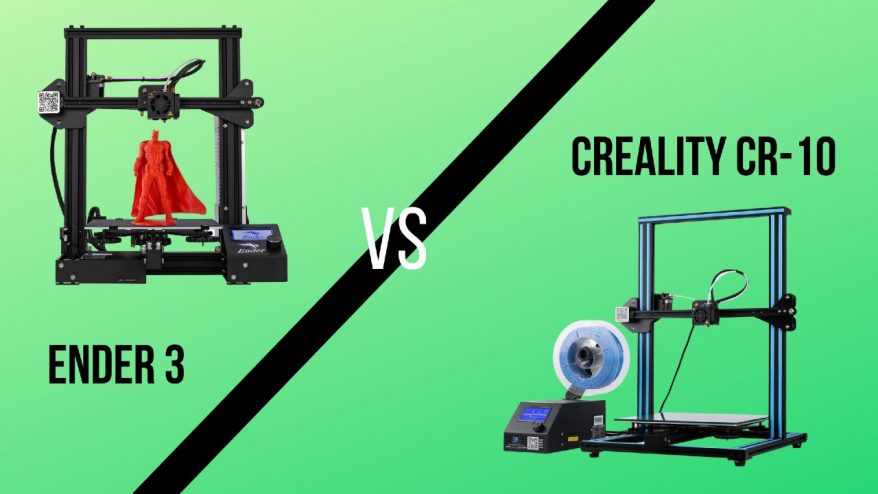
Buying the right 3D printer can be a tricky business, especially when trying to decide between two of Creality’s leading budget printers – Ender 3 vs CR-10.
Both are great printers in their own right, but what sets them apart?
The key differences lie in their build volumes and price points. The Ender 3 is a budget-friendly option with a smaller build volume, while the CR-10 offers a massive build volume at a slightly higher price point.
But that’s not the whole story!
In this guide, I’ll compare my hands-on experience with both printers across other key points like material compatibility, bed leveling, and ease of assembly so you can be confident about which is right for you.
We’ll also take a look at the newer Ender releases (V2, Pro, and S1) alongside the CR-10 V2 and CR-10 V3 in case you need to step beyond the beginner options.
Is the CR-10’s mammoth build volume worth the extra cost? Has the Ender 3 lost some of its luster over the years? Let’s find out.
BUDGET PICK
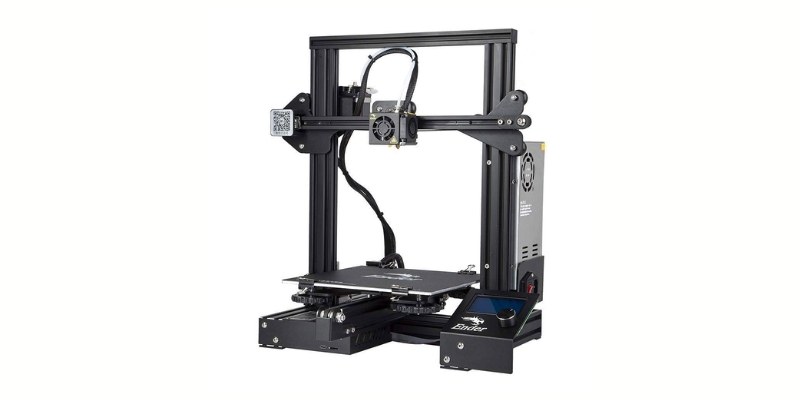
Creality Ender 3
Available at:
BUILD VOLUME PICK
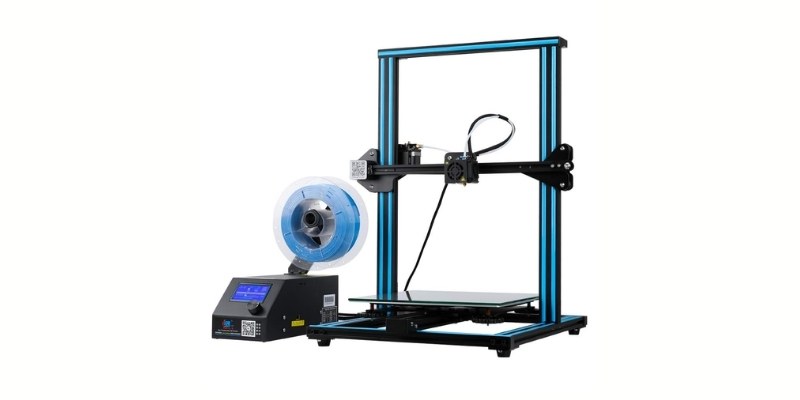
Creality CR-10
Available at:
Creality Ender 3 vs Creality CR-10 – Reviews
3DSourced is reader-supported. When you buy through links on our site, we may earn an affiliate commission. Learn more
Creality Ender 3
- Printing technology: FDM
- Build volume: 220 x 220 x 250 mm
- Filament compatibility: PLA, ABS, TPU, PETG
- Layer height: 100-400 microns
- Printing accuracy: ± 0.1 mm
- Max extruder temp: 255°
- Max bed temp: 110°
- Connectivity: USB, SD Card
The budget king, the Creality Ender 3 is an entry-level 3D printer that despite looking a little long in the tooth remains one of the most widely-lauded options on the market.
The machine features everything you need to start your 3D printing journey in style:
- a 220 x 220 x 250 mm build volume
- PLA/ABS/TPU/PETG filament compatibility
- a heated BuildTak-style print bed
- and it ships semi-assembled
More pressingly, the Ender 3’s reliable print quality feels at odds with the asking price.
There’s little in the way of hobbyist applications the Ender 3 can’t tackle. It’s also ripe for tinkering and mods, powered by a massive community happy to impart their extensive knowledge should you stumble and share all manner of mods you can install yourself.
If the basic Ender 3 doesn’t tick all your boxes, the updated Ender 3 Pro and Ender V2 are spruced up iterations, bundling in targeted upgrades such as a silent 32-bit mainboard, a carborundum glass platform, a Mean Well PSU, handy belt tensioners, and a sharper overall look and feel.
Pros:
- Affordable
- Excellent print quality for the price
- Mod and hack-friendly
Cons:
- Wobble-prone Y-axis extrusion
- Manual bed leveling
Read more: our Ender 3 review
Creality CR-10
- Printing technology: FDM
- Build volume: 300 x 300 x 400 mm
- Filament compatibility: PLA, ABS, TPU, PETG
- Layer height: 100 microns
- Max extruder temp: 250°
- Max bed temp: 100°
- Connectivity: USB, SD Card
Though it hasn’t left quite the same indelible mark on the 3D printing scene as the Ender 3, the Creality CR-10 gets mentioned alongside for offering a hulking build volume at, once again, a price the average person can afford.
The emphasis with the Creality CR-10 is very much on size: the 300 x 300 x 400 mm dwarfs most other budget printers. We’ve owned and tested the CR-10 Smart and felt it was an interesting upgrade, with other notable upgrades (V2 and V3) also improving on the base design.
Best of all, supersizing doesn’t affect print quality. Much like the Ender 3, the Creality CR-10 has no business printing as well as it does for the price and rarely skips a beat for day-to-day hobby printing.
Other notable features include compatibility with popular filament types like PLA, ABS, and TPU, a beefy aluminum frame, a heated glass bed, and a simple yet functional design.
The base CR-10’s popularity pushed Creality to pump out successor models, namely the CR-10 V2 and CR-10 V3. These are new and improved versions tweaked based on feedback gathered from the community.
Enhancements include a direct drive E3D extruder, 24V Mean Well PSU, a filament run-out sensor, TMC-208 silent drivers, and what Creality calls ‘gold triangle’ support rods to improve frame stability.
Pros:
- Massive build volume
- Affordable
- A tinkerer’s playground
- Reliable print quality
Cons:
- Manual bed leveling
- Slow heating bed
- 8-bit motherboard
Read more: our CR-10 Smart review
Creality Ender 3 vs Creality CR-10 – At a Glance
With introductions out of the way, we can now turn our attention to a head-to-head showdown between Creality’s flagship budget printers.
At this point, it’s worth remembering that ‘best’ is a highly subjective term.
While we’ll help get an overview of what each printer is all about and where they shine brightest, they aren’t direct competitors, each catering to a different set of needs. It’s up to you to decide which aligns best with your requirements and 3D printing aims.
The Ender 3 is a solid pick for a first printer.
It’s less barebones than the Creality CR-10, and it has a great stack of features for the price with plenty of scope for upgrades but at a cost to overall build volume.
It’s also more affordable than the CR-10, even in its best-yet V2 iteration.
If you need plenty of build volume, the Creality CR-10 is the best choice here. The Creality CR-10 V3, in particular, is the culmination of the CR-10’s long journey: a superb extruder, a sturdy frame, a carborundum glass bed, and ever-surprisingly good print quality for the price.
Generalities aside, let’s see how the two compare when we look at specifics.
Creality Ender 3 vs Creality CR-10 – Head-to-Head Comparison
Build Volume
Large build volumes can be costly, but with the Creality CR-10, they’ve become as affordable as other budget 3D printers.
The Creality CR-10 (including the V2 and V3) offers a 300 x 300 x 400 mm build volume, while the Ender 3 (once again in all its iterations) sticks to a standard 220 x 220 x 250 mm.
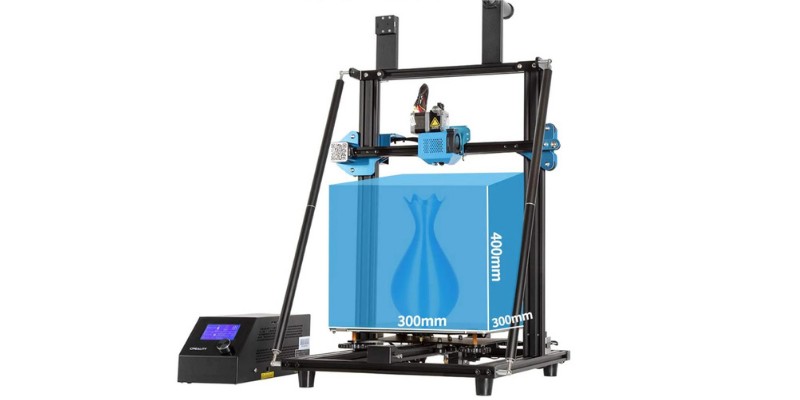
The numbers speak volumes here, and the Creality CR-10 is great for makers with plans to print larger parts and models. Creality cranks things up with the V2 and V3 models with the ‘gold triangle’ design mentioned above.
Extra support rods beef up the frame to reduce potential unwanted movement when the extruder runs along the Y-axis, even when pushing to the upper limits of the build volume.
The Creality CR-10 takes the lead here, but only if you need the extra print space. Otherwise, the Ender 3’s build volume is standard fare and should cover daily printing nicely.
Winner: CR-10
Print Plate
There’s a lot of build plate variety among all the available Ender 3 and CR-10 models.
The vanilla Ender 3 features a heated magnetic BuildTak-style print bed. It does the job but may require drafting in some adhesive help such as glue, slurry, or sticky tape for the best results. The Ender 3 Pro levels up to a textured C-MAG magnetic plate, a significant advantage over the original.
The Ender 3 V2 takes it one step further, fitting in a tempered carborundum glass platform, the best of the bunch for adhesion and easy print removal.
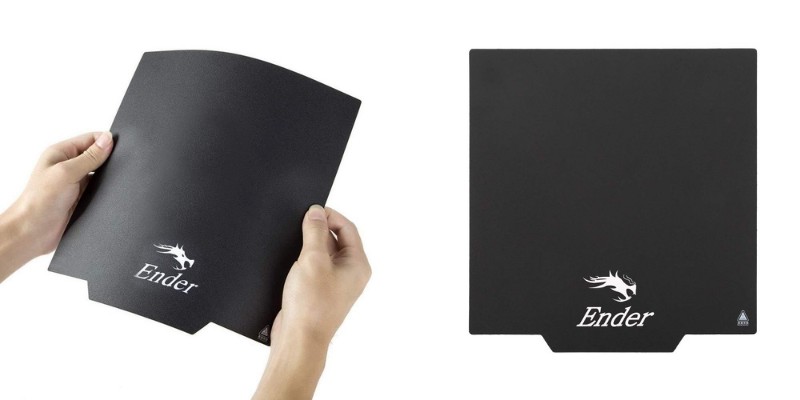
Jumping to the Creality CR-10, the basic model has a rudimentary heated glass plate, while the V2 and V3 jazz things up with a carborundum glass plate.
Like the Ender 3 Pro and V2, the improved glass plate does wonders for adhesion and print removal.
Overall, the two printers are roughly on par with one other in each category. Due to the size of the CR-10’s plate, it takes longer to reach the optimum printing temperature than the smaller Ender 3.
A reasonable trade-off for the extra print volume, but a point to keep in mind if you’re working with ABS or prefer a quick heating bed. Creality replaces the 12V PSU for a 24V Mean Well unit in the CR-10 V2 and V3, which does help with heating speeds and consistency.
Winner: Draw
Material Compatibility
Both printers’ filament compatibility covers your generic 3D printing materials, namely PLA, ABS, TPU, PETG.
Both machines fare best when working with PLA and produce decent print quality using TPU and PETG.
ABS is somewhat of a mixed bag, chiefly due to the lack of an enclosed chamber – a crucial piece of the ABS puzzle for keeping a steady toasty ambient temperature – on both the Ender 3 and CR-10. With that in mind, we call it a draw for material compatibility.
Winner: Draw
Bed Leveling
All six Creality Ender 3 and CR-10 3D printers have manual bed leveling. Par for the course in the budget segment.
The chunkier and labeled leveling knobs found on the Ender V2 and Pro are great at easing some of the trickiness of bed leveling. The CR-10 bed leveling has remained essentially unchanged since the original version – unremarkable but functional, even for a novice.
The Ender 3 V2 and CR-10 V2/V3 house ports to install a BLTouch automatic bed leveling probe on the mainboards.
A wise and affordable upgrade in our book because, whatever your level of 3D printing experience, manual bed leveling is tedious and time-consuming.
Winner: Draw
Assembly
The Ender 3 lands on your doorstep semi-assembled, whether that’s the original, Pro, or V2, but you’re still presented with quite a few parts to piece together. It’s a great introduction to the technology and hardware of 3D printing in that respect.
Well-guided instructions and good quality machining should see you mount it into a functioning printer in a couple of hours.
The CR-10 ships semi-assembled, but this is far more consistent with what we expect these days. You’ll need to attach the Z-axis to the base, connect a few wires, and you’re ready to go.
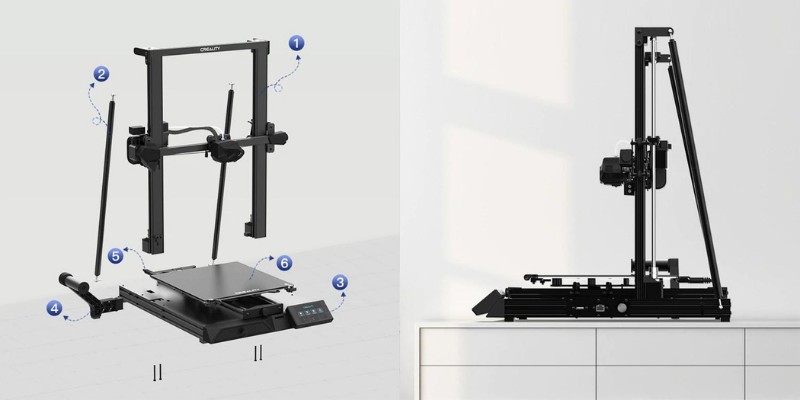
Expect to spend no more than 30 minutes, at most, even if this is your first printer. For convenience alone, the CR-10 takes the crown here.
Winner: CR-10
Build and Part Quality
The Ender 3 and CR-10 in all their incarnations feature a sturdy frame and overall solid build quality.
The Ender 3’s Y-axis extrusion has been known to cause wobble for some users, something that’s been rectified by a thicker extrusion on the Ender 3 Pro and Ender 3 V2.
The Ender 3 features a 32-bit motherboard, while the CR-10 relies on a modest 8-bit variant, complicating the installation of firmware updates.
Similarly, the CR-10 features a 12V board compared to the Ender 3’s 24V, leaving you with little in the way of additional power for upgrades. The CR-10 V3 features a 24V Mean Well PSU, so look to that model if you need that extra power.
Note that the CR-10 PSU exists outside the frame, so factor this into the printer’s already sizable physical footprint.
While the Ender 3 and CR-10’s standard Creality extruder gets the job down, notwithstanding the occasional longevity issue due to some plastic construction, we’re partial to the workhorse characteristics of the all-metal direct drive E3D Titan extruder on the CR-10 V3.
No clear winner here, as each has its flaws. It’s more a case of what is less likely to cause you irritation.
Winner: Draw
Software
The Ender 3 and CR-10 stand on equal footing in software compatibility. They play well with all the most popular third-party slicers such as Cura, Simplify3D, and Slic3r, to name a few.
Winner: Draw
Price
Here’s a breakdown of the pricing for each Ender 3 and CR-10 model currently available, as seen on the Creality Store. You may find higher or lower prices at third-party retailers.
- Ender 3 – $189 — Available here
- Ender 3 Pro – $219 — Available here
- Ender 3 V2 – $262 — Available here
- CR-10 – $309 — Available here
- CR-10 V3 – $459 — Available here
At under $200, the Ender 3 wins as the most affordable option considering its features and the print quality on offer. It’s worth noting that the basic CR-10 costs more than the top Ender 3 V2, chiefly due to the much larger build volume.
We recommend avoiding the Ender 3 Pro entirely, instead paying less for the Ender 3 or spending a bit more on the superior Ender 3 V2. Similarly, if you can afford the CR-10 V2, we recommend paying a bit more for the CR-10 V3 for the benefits it offers.
Winner: Ender 3
Creality Ender 3 vs Creality CR-10: The Winner
Creality Ender 3 vs Creality CR-10 – Best Overall
For us, the Ender 3 retains its crown as the go-to pick for savvy 3D printing beginners.
The most recent Ender 3 V2 highlights Creality’s efforts to weed out the issues of its successors while still keeping the core of what makes it a favorite among makers. More importantly, the original and V2 are priced lower than the basic CR-10.
We’re all guided by budget, and you get an awful lot of printing vim for the price.
BUDGET PICK

Creality Ender 3
Available at:
BUILD VOLUME PICK

Creality CR-10
Available at:
Creality Ender 3 vs Creality CR-10 – Best Value Option
If day-to-day hobby printing is more your speed and you’ve no plans to pump out towering parts or models, the Ender 3 packs in the most value.
Best of all, the vanilla Ender 3 is ripe for upgrades that you can print yourself, turning it into a machine that surpasses not just the Pro version but flirts with the V2 at a fraction of the cost.
Creality Ender 3 vs Creality CR-10 – Best For Large Prints
If you’re comfortable sacrificing certain features like print recovery and faster bed heating for the sake of build volume, we recommend the Creality CR-10.
The Ender 3 is our top pick, but no amount of tweaks and improvements can make up for a smaller build volume.
Articles we recommend:
- Ender 3 vs Ender 5
- Ender 3 vs Ender 3 Pro, V2 and Max
- Ender 3 V2 vs Prusa Mini
- Ender 3 V2/S1 vs Prusa i3 MK3S+
- Sovol SV06 vs Ender 3 (V2 / Neo)
- Alternatives to the Ender 3 3D printers
- Ender 5 vs Ender 5 Pro vs Ender 5 Plus
- Elegoo Mars 3 vs Elegoo Saturn
- Anycubic Mono X vs Elegoo Saturn
- Flashforge Adventurer 3 vs 3 Lite
- Anycubic Kobra vs Plus vs Max
- Creality CR-10 upgradables



